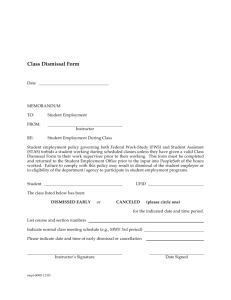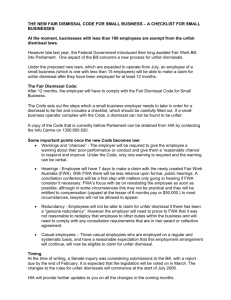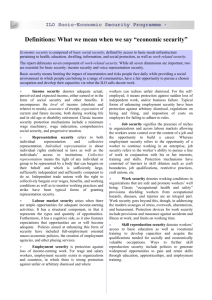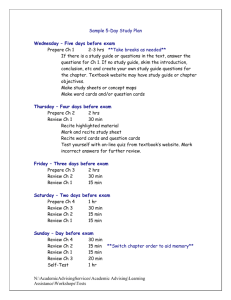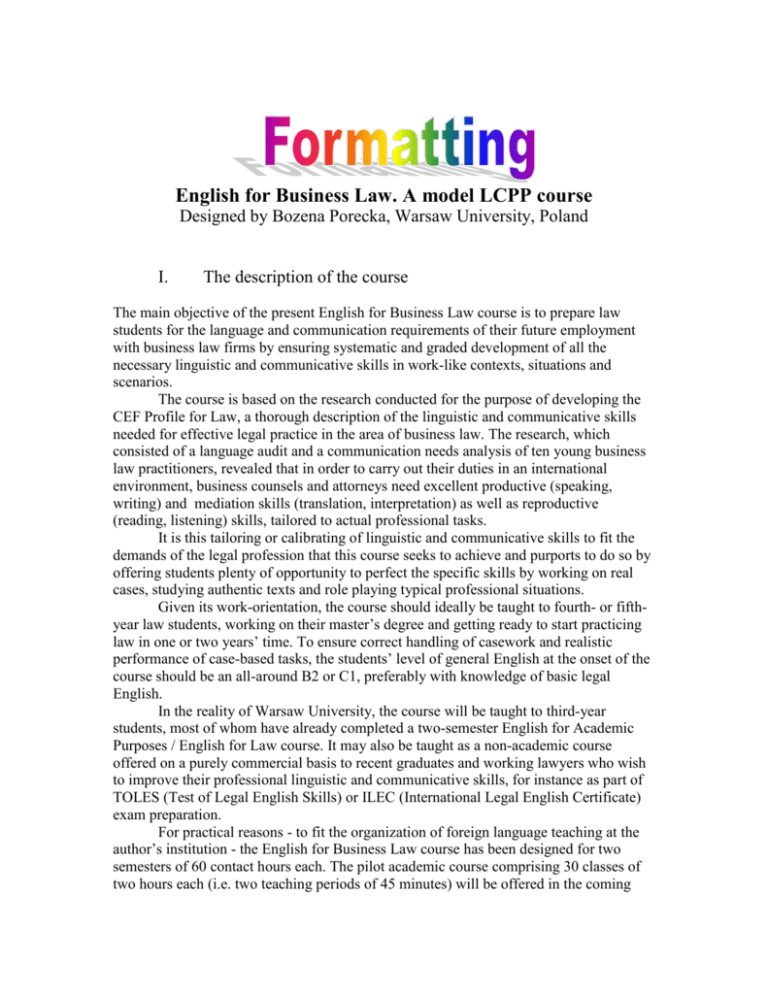
English for Business Law. A model LCPP course
Designed by Bozena Porecka, Warsaw University, Poland
I.
The description of the course
The main objective of the present English for Business Law course is to prepare law
students for the language and communication requirements of their future employment
with business law firms by ensuring systematic and graded development of all the
necessary linguistic and communicative skills in work-like contexts, situations and
scenarios.
The course is based on the research conducted for the purpose of developing the
CEF Profile for Law, a thorough description of the linguistic and communicative skills
needed for effective legal practice in the area of business law. The research, which
consisted of a language audit and a communication needs analysis of ten young business
law practitioners, revealed that in order to carry out their duties in an international
environment, business counsels and attorneys need excellent productive (speaking,
writing) and mediation skills (translation, interpretation) as well as reproductive
(reading, listening) skills, tailored to actual professional tasks.
It is this tailoring or calibrating of linguistic and communicative skills to fit the
demands of the legal profession that this course seeks to achieve and purports to do so by
offering students plenty of opportunity to perfect the specific skills by working on real
cases, studying authentic texts and role playing typical professional situations.
Given its work-orientation, the course should ideally be taught to fourth- or fifthyear law students, working on their master’s degree and getting ready to start practicing
law in one or two years’ time. To ensure correct handling of casework and realistic
performance of case-based tasks, the students’ level of general English at the onset of the
course should be an all-around B2 or C1, preferably with knowledge of basic legal
English.
In the reality of Warsaw University, the course will be taught to third-year
students, most of whom have already completed a two-semester English for Academic
Purposes / English for Law course. It may also be taught as a non-academic course
offered on a purely commercial basis to recent graduates and working lawyers who wish
to improve their professional linguistic and communicative skills, for instance as part of
TOLES (Test of Legal English Skills) or ILEC (International Legal English Certificate)
exam preparation.
For practical reasons - to fit the organization of foreign language teaching at the
author’s institution - the English for Business Law course has been designed for two
semesters of 60 contact hours each. The pilot academic course comprising 30 classes of
two hours each (i.e. two teaching periods of 45 minutes) will be offered in the coming
academic year of 2007/2008 in the fall and spring semesters. A pilot commercial course
with 20 three-hour sessions is also scheduled to start this October as part of two-year
ILEC preparation, providing there is sufficient enrolment.
II.
The contents of the course
The contents of the course have been informed by the findings of the lawyers’ needs
analysis conducted by the author with respect to topics, texts and vocabulary selected for
studying, competences targeted in each course segment and professional situations
practiced in class.
As regards legal topics (and so – professional vocabulary repertoires), those
included in the course match the specific practice areas enumerated by the interviewed
lawyers as those most frequently requiring the use of English, namely: commercial law,
company law, employment law, contract law, banking law, competition law, real property
law, intellectual property law, law on public orders, civil litigation and arbitration, tax
law and administrative law. However, unlike in the actual legal practice, the classroom
rendering of these topics is not restricted to domestic and EU law, but includes relevant
British and American concepts, institutions, acts and cases for linguistic, cultural and
cognitive reasons.
Likewise, the choice of professional situations to be practiced in class is based on
the listing of frequent situations provided by the respondents, and including: reading legal
texts (acts, documents, contracts), writing electronic and traditional correspondence,
drafting legal agreements and documents, conducting professional talks and negotiations,
making speeches and presentations, participating in tele- and video conferences, engaging
in office and social talks, taking part in business social events, and attending training
seminars and workshops.
The competences targeted have been determined by analyzing the frequent FL
situations mentioned by the interviewees, with their typical scenarios and task
descriptions. Consequently, a special focus has been given to productive, communicative
and interactive skills, both because they merit particular attention as key lawyer skills and
because those polled saw them as insufficiently mastered, needing further development
and occasionally hindering their professional effectiveness.
A complete list of legal topics to be covered in the course is given below. It
consists of 17 topics, 9 in the first semester and 8 in the second, of uneven length but the
same internal organization revolving around a fairly complex professional situation,
involving a variety of realistic tasks based on a simple but instructive case.
By way of acknowledgement, it should be said that not all the cases have been
found by the author and not all task ideas are entirely original. In preparing the model
course the author has used these recently published British legal English books as sources
of authentic English written and oral texts, as well as ideas for classroom activities and
home assignments:
1. Krois-Lindner, A. & TransLegal, International Legal English, Cambridge University
Press 2006 (with two CDs and a Teacher’s Book by Jeremy Day)
2. McKay, W.R., Charlton, H.E., Legal English, Pearson Longman 2005
2
3. Haigh, R., Legal English, Cavendish Publishing 2004
4. Haigh, R., Legal Correspondence, Oxford University Press 2006
5. Brown G. D., Rice, S., Professional English in Use. Law, Cambridge University Press
2006
In fact, it is recommended that the students buy the Krois-Lindner book as it will be used,
albeit selectively, for most of the topics and because it is geared to ILEC preparation,
which is particularly relevant to commercial students.
SEMESTER 1 (60 contact hours)
Classes
/Hours
Classes
1-2
4 hrs
Classes
3-5
6 hrs
Topic / Vocabulary
Professional situations practiced
Legal education:
Law studies and degrees,
Professional exams
Career opportunities
The legal profession:
Careers in law
Job advertisements
Applying for legal jobs
CV and application writing
Student exchange:
Exchanging information about one’s law
studies and legal education in student
exchange contexts (Erasmus)
Gaining employment:
Enquiring about a legal job
Reading job advertisements
Applying for a job with a law firm,
Writing a CV and a letter of application
Attending a job interview
Job orientation:
Presenting information about one’s
employer in an initial conversation with
a client and at a PR/ promotional event
Defining counselling and representation
Describing legal jobs in detail
Advising a client in a company
formation case:
Holding a case-orientation meeting to
clarify the lawyer’s task
Writing case-related correspondence
(electronic and traditional)
Answering the client’s inquiry or request
for advice
Classes
6-8
6 hrs
The business of a law firm:
Practice areas in business law
Counselling and representation
The structure of a law firm
Positions and job descriptions
Classes
9-12
8 hrs
Company law (1):
The scope of company law
Relevant legislation
Types of businesses in Poland, the UK,
the USA
The procedure of forming a company
Documents and institutions involved in
company formation
The lawyer’s role in company formation
Company law (2):
The structure of a limited company
Management and shareholders in a
public/listed company
Shareholders’ rights and obligations
Types of shares
Shareholders’ meetings and resolutions
Executive board and supervisory board
Mergers and acquisitions
Classes
13-16
8 hrs
3
Advising a corporate client in cases
involving company governance and
change, including mergers and
acquisitions (M&A)
Coaching the client in legal aspects of
strategic business decisions
Explaining the procedure of executing a
management change in a limited
company
Explaining legal aspects of a merger or
Classes
17-20
8 hrs
Contract law (1):
The language of contracts (“Legalese”,
legal Latin, fixed phrases)
Types of contracts
The structure and layout of a contract
Classes
21-24
8 hrs
Contract law (2):
Contract preamble and recitals
Standard contract clauses
Contract validity
Contract remedies and breaches
Classes
25-26
4 hrs
Contract law (3):
Contract negotiations
Class
27-29
6 hrs
Contract litigation
Typical contract-related lawsuits
The lawyer’s role in contract litigation
Contract assignment and third party rights
Class 30
2 hrs
Term test
A 90-minute written exam consisting of
a listening test, a reading test, a translation
test, and a vocabulary test dealing with
topics covered
an acquisition
Using legal English to ensure language
accuracy in international contexts
Summarizing English legal texts in plain
English
Interpreting legal English for the client
Explaining Polish legal concepts in plain
English and in “legalese”
Procurement of a contract on the
client’s commission
Holding a meeting with the client to
agree the contents and phrasing of the
commissioned contract
Drafting a typical contract
Representing a client in trade
negotiations:
Negotiating a contract on behalf of the
client
Agreeing the negotiating strategy and
fallback position with the client
Using different negotiating techniques
Representing a corporate client in
contract litigation
Preparing a lawsuit and developing an
argument
Speaking in court or arbitration
proceedings on behalf of the client
Reporting on the progress of the case to
the client
SEMESTER 2 (60 contact hours)
Classes
/Hours
Classes
1-4
8 hrs
Topic / Vocabulary
Professional situation practiced
Employment law (1)
Framework of employment law
Rights and obligations of employers and
employees
A standard employment contract
EU discrimination legislation
Discrimination cases
Advising a client in disputes over
interpretation of employment contracts
and discrimination claims
Interpreting the meaning of standard
terms and conditions of employment
Briefing a foreign client on Polish
employment law
Identifying discriminatory practices
according to EU directives
4
Classes
5-8
8 hrs
Employment law (2)
Fair and unfair dismissals
Issuing and defending an unfair
dismissal claim in an employment
tribunal or arbitration proceedings
Liability risks
Classes
9-11
6 hrs
Marketing agreements
Agency agreements
Distribution agreements
Franchising agreements
Joint-venture agreements
Classes
12-14
6 hrs
Sale of goods legislation
Transfer of title
Warranties and disclaimers
Rights and obligations of the seller and
the buyer
Consumer rights legislation
Classes
15-17
6 hrs
Competition law (1)
The scope of competition law
Anti-competitive activities
Classes
18-21
8 hrs
Competition law (2)
EU anti-trust measures
Competition law arbitration
International cases involving
competition law
Classes
22-25
8 hrs
Real estate law
Lease and tenancy agreements in Britain
Tenant’s and landlord’s rights and
obligation
Land ownership vs. perpetual usufruct
Risks in land law
Classes
26-29
Intellectual property law
Patents
5
Advising a corporate client how to handle
a discrimination claim by an employee
Advising a corporate client acting in an
unfair dismissal case
Analyzing an unfair dismissal claim
issued by an employee
Suggesting steps to take in order to
contest an unfair dismissal claim
Agreeing and drafting statements to be
used in an unfair dismissal case
Counselling a client about liability risk
Drafting a marketing agreement for a
client
Analyzing different marketing agreements
Amending a standard marketing
agreement according to the client’s
instructions
Advising a client in a sale-case; drafting
a sale contract
Informing the client about their obligation
as the seller
Briefing the client on consumer rights
legislation
Suggesting what safeguards to apply in a
sale contract
Advising a client on competition law
risks:
Briefing the client on Polish anti-trust law
Presenting legal consequences of an anticompetitive practice
Writing a case brief
Representing a client in competition
law arbitration
Holding a meeting with the client to
prepare for the arbitration proceedings
Developing arguments
Writing case briefs
Reporting on similar cases
Advising a corporate client in real
estate cases (leasing office space and
buying land)
Explaining the concept of easement
Counselling the client about their rights
and obligations as tenant or landlord
Interpreting and translating tenancy
agreements
Explaining a specifically Polish institution
of perpetual usufruct to a foreign client
Advising a client on patents and
business method patents
8 hrs
EU legislation on trademarks
Cybersquatting
Internet domain names
Class 30
2 hrs
Final test
A 90-minute test of listening, reading
and writing modelled on the ILEC exam
III.
Interpreting legislation on intellectual
property
Explaining the procedure used to obtain a
patent
Handling formalities of patent application
Explaining consequences of breaching the
intellectual property law
Counselling in an internet domain case
The coursework: activities, assignments and assessment
As the above listing of topics, professional situations and competences targeted
hopefully makes clear, the foremost objective of the course is to develop full
communicative competence of the learners (i.e. linguistic, sociolinguistic, cultural and
pragmatic) by partly re-creating the realities of an international legal practice in a
language classroom. To achieve this, the realization of each topic falls into three stages:
exposure, preparation and simulation. In the exposure stage students are introduced to
relevant legal texts: extracts from legislation, press articles, contracts, agreements and
other documents used in a given practice area, recordings of professional meetings, case
briefs etc., either given as handouts or prepared by students as home-assignment research
tasks. This is followed by simulated practical application of the knowledge and acquired
vocabulary to concrete cases, handled in a step-by-step manner modelled on actual legal
practice, where a case is thoroughly researched and consulted before any counselling or
document procurement can take place.
To ensure maximum realism, all the classroom activities and home assignments
within each thematic segment are logically connected, structured and graded for
complexity and linguistic difficulty. The communicative orientation of the course
requires the use of a variety of interactive activities, calling for a variety of dyadic, group
and public communication, including discussion, debate, interviewing, presenting
information, argumentative speech making and negotiations, while oral and written home
assignments constitute class preparation and/or follow up. The following examples show
how this is done in practice.
Example One
Segment / topic: The legal profession (Semester 1, topic 2)
Total class time: 6 hours (3 classes of two teaching periods each)
Situation practiced: Gaining employment
Competences targeted: Finding legal job offers, reading job ads, enquiring about job offers,
interviewing people to find out relevant information, writing application documents (CV, letter of
application), preparing for a job interview, making suggestions and giving advice.
Texts used: Authentic advertisements for legal jobs, sample lawyer CVs and application letters
(sources of texts: International Legal English, Pearson’s Legal English, the press, the Internet)
6
Activity 1 – Employment opportunities in law
Working as a class the students make a list of legal jobs and employers. They rate the jobs on
availability and attractiveness.
Activity 2 – Job hunt vocabulary overview
In pairs, the students analyze sample job ads provided by the teacher, commenting on their
language, structure and content. The teacher calls upon several pairs to present their findings and
clarifies any vocabulary problems (e.g. abbreviations used for areas of legal practice). Then,
working as a class the students identify stages of the job hunt and application process, reviewing
the relevant vocabulary.
Activity 3 – Helping a friend find a legal job
In groups of four, students role play a situation in which one of them is looking for a legal job
that would match his qualifications and preferences and asks his three already working friends for
help. The Friends try to find out exactly what qualifications and employment preferences he/she
has and offer some general advice by asking questions. Only the Job Seeker’s role is described in
details, other role descriptions are limited to job titles and employers.
Home assignment 1 – Finding job offers
Students who role played Friends in Activity 2 try to find suitable job offers for the Job Seeker in
the trade press, on the Internet and through personal connections (e.g. parents holding legal jobs).
All offers found have to be researched for information about the prospective employer; those in
Polish have to be translated into English.
Activity 4 - Analyzing job offers
Working in the original groups, the Friends and the Job Seeker read, analyze and compare the job
ads found. They discuss their requirements and benefits, and choose the most promising offer.
The Job Seekers present their chosen job offers to the entire class, role playing a face-to-face or
telephone conversation with a parent or friend in which they enthusiastically talk about the job
they want to apply for.
Activity 5 – Discussing employment prospects
Acting as themselves now, the students comment on the job offers selected as the most promising
in Activity 3. They outline an ideal candidate for each and discuss factors contributing to making
a success at the recruitment process (e.g. quality of application documents, interview preparation,
interpersonal interviewing skills).
Activity 6 – Getting ready for the selection process
Working in groups, the students brainstorm information on how to: write a good CV (Group 1),
write an effective letter of application /motivation letter (Group 2), prepare for a job interview
(Group 3), behave at a job interview (Group 4), without consulting any external sources. A
selected spokesperson of each group makes an improvised presentation summarizing the group’s
conclusions.
Activity 7 – Effective CV and letter of application writing
Working in pairs, the students study the examples of lawyer CVs and letters of application
provided by the teacher, analyzing their content, structure, layout and language. Then, the teacher
shows them a poorly written lawyer CV on an OHP and asks them to give their criticism and
suggest ways of improving it.
7
Home assignment 2 – Writing a CV and a letter of application
The assignment consists in writing an effective CV and letter of application in answer to one of
the job ads studied in class. The students are asked to use their biographical facts, but invent any
necessary details to make them suitable candidates for the job they have chosen. The assignment
is graded.
Example Two
Segment / topic: Employment law 2 – Unfair dismissal (Semester 2 topic 2)
Total class time: 8 hours (4 classes of two teaching periods each)
Situation practiced: Advising a client (a Claimant and a Respondent) in an unfair dismissal case
Competences targeted: Analyzing an employee unfair dismissal claim in the light of employment
legislation, describing the institution of Employment Tribunal and the procedure it follows to hear
unfair dismissal claims, advising an employee who has been unfairly dismissed, counselling an
employer wishing to contest an unfair dismissal claim, agreeing and drafting statements to be
used in an unfair dismissal case, counselling a corporate client about liability risks, comparing
Polish and British employment law and the procedures for unfair dismissal cases.
Texts used: extracts from British and Polish legislation on unfair dismissal, samples of ET
documents: Statement of the Applicant, Application to an Employment Tribunal, Notice of
Appearance, Witness Statement (sources: Pearson’s Legal English, International Legal English,
the Internet)
Home assignment 1 - Case preparation
The students are divided into two groups with different homework to do. Group A is given the
task of reading relevant extracts from the Employment Rights Act 1996 (ERA) about unfair
dismissal, while Group B has to find information about an Employment Tribunal (ET), the venue
for hearing such cases.
Activity 1 – Exchanging information
In groups of four (two students from each assignment group), the students exchange information
gathered as homework. The teacher checks their work by asking various factual questions about
the ERA and an ET.
Activity 2 – Analyzing a Claimant’s statement
Working in the same small groups, the students read a statement written by an employee claiming
unfair dismissal, discuss it, and decide whether the Claimant has a case (Yes) and what steps have
to be taken.
Activity 3 - Advising the Claimant
The students work in pairs: one role plays the Claimant, the other plays his lawyer giving advice
on how to handle the claim based on the results of the group brainstorming in Activity 1.
Activity 4 – Filling in an Application to an Employment Tribunal
Working in the same Client/Lawyer pairs, the students fill out an ET Application (forms provided
by the teacher). Each pairs compare their version of the Application with their neighbours’ and
discuss any differences that occur. This is followed by a general discussion regarding the form of
redress the Claimant should seek.
Activity 5 – Considering the case from the Respondent’s point of view
Working in groups of four the students try to determine whether and how the unfair dismissal
claim can be resisted in the case studied. One student plays the role of the case witness, whose
8
testimony resulted in the Claimant’s dismissal. The others interview him/ her for details and with
his help write a proper Witness Statement according to a format provided.
Activity 6 – Language work
Working in the same groups as before, the students evaluate each other’s work: each group
checks a Witness Statement written by another group for grammatical and vocabulary errors and
corrects them. The teacher collects the corrected statements for assessment. The original versions
are kept by the students for reference while doing a home assignment.
Home assignment 2 – Advising the Respondent
Acting as the Respondent’s lawyer, the students (working in pairs) write an e-mail to their client
suggesting a way of resisting the claim and proposing a course of action. The assignment is
subject to random checking and grading.
Activity 7 – Class debate: Who wins the case?
The students are asked to take either the Claimant’s or the Respondent’s side, depending on
whose chances of winning the case they consider better. Those who cannot decide are assigned
the role of an Employment Tribunal. The Tribunal then listens to the debate and makes their
decision regarding the claim and compensation.
Activity 8 – Evaluating a fellow lawyer
The student’s listen to a recording of a meeting between a lawyer and a respondent in an unfair
dismissal claim and read the subsequent correspondence between them. They make comments
evaluating the performance of the lawyer: her professionalism, the quality of her advice, etc.
They are also encouraged to comment on the language used by the lawyer towards her client in
face-to-face as well as e-mail communication.
Activity 9 – Discussing liability risk
In groups of four, the students list other types of work-related disputes between employees and
employers, and try to connect them to the notion liability risk faced by employers. Groups share
their findings about actions by employers that are likely to result in a lawsuit or a claim brought
by an employee (e.g. drug testing, HIV testing, control of internet use).
Home assignment 3 – Polish Employment law cases
The students are asked to find an interesting Polish case involving issues of employment law
(discrimination, unfair dismissal, mobbing) and prepare an oral report on it. Several students give
their reports to class.
As the above examples make evident, the course calls for constant monitoring of the
students’ work and frequent grading of their performance on both home assignments and
classroom activities. The overall grading principle is that each student is graded on a
research task done as case preparation, participation in a communicative group activity (a
role play), an individual oral presentation and an individual written assignment. This
means that assessment is done on a continual basis and that some students are graded on
every major communicative activity. In addition, there is a written exam given at the end
of each semester, which is intended to check the students’ ability to read, write and
translate business law texts using appropriate terminology in an academic testing
environment, i.e. without any access to reference books or dictionaries. This allows the
teacher to check purely linguistic skills, such as vocabulary retention or register and
structural correctness, in a traditional way.
9


